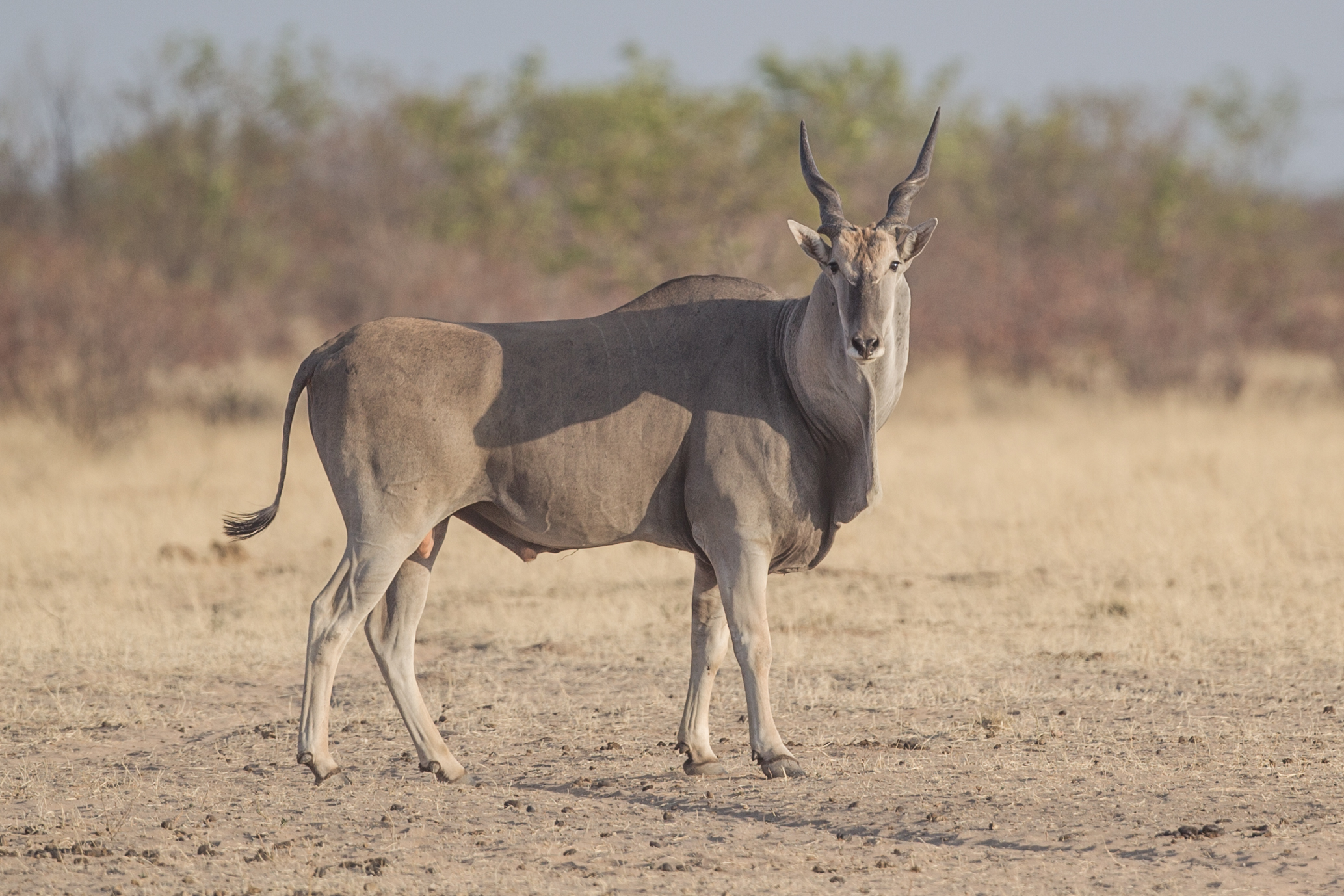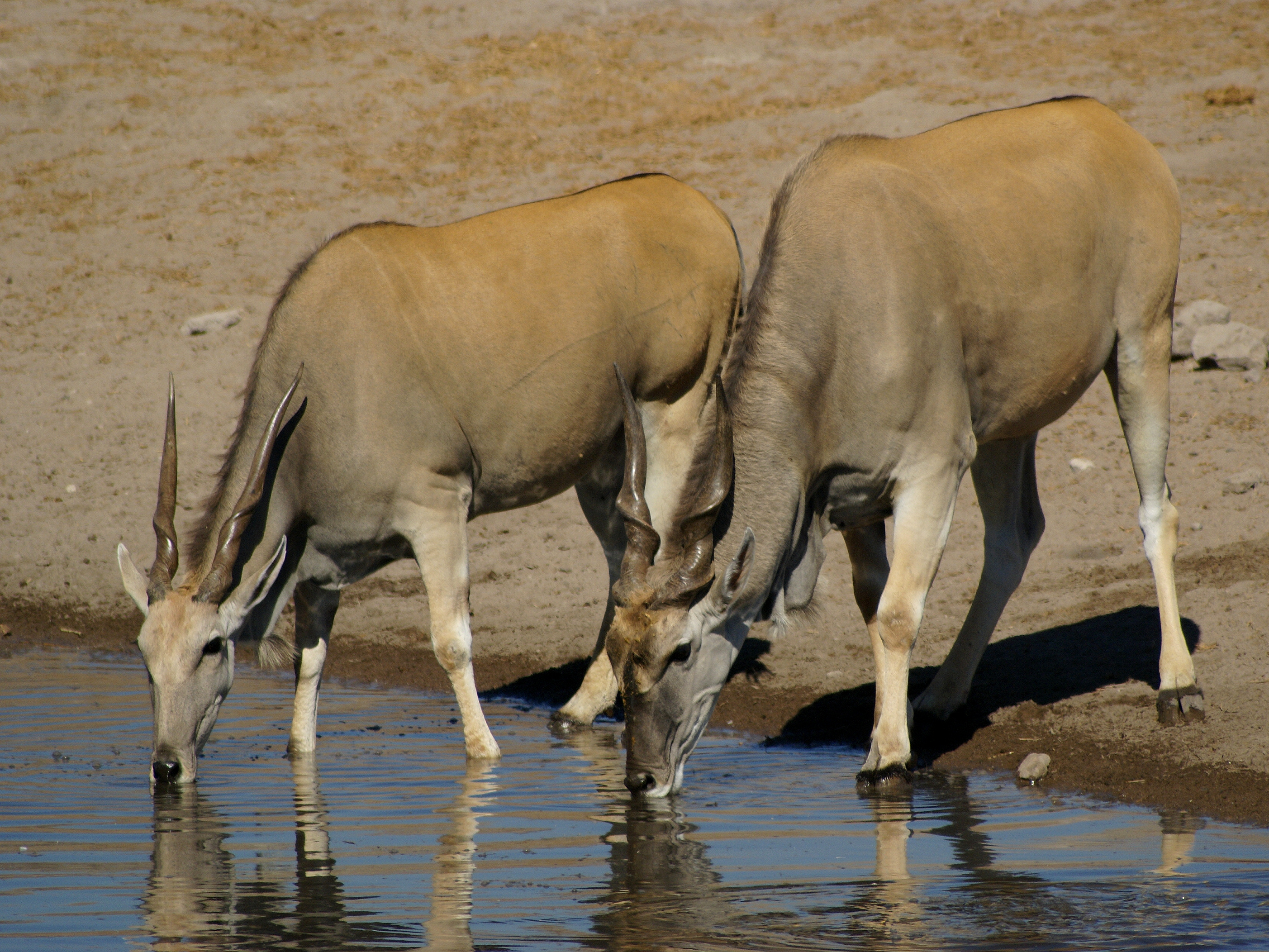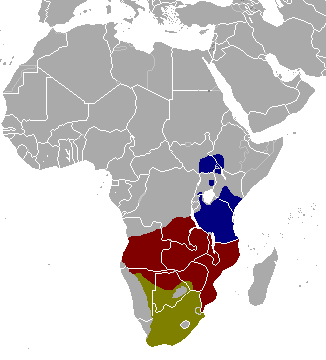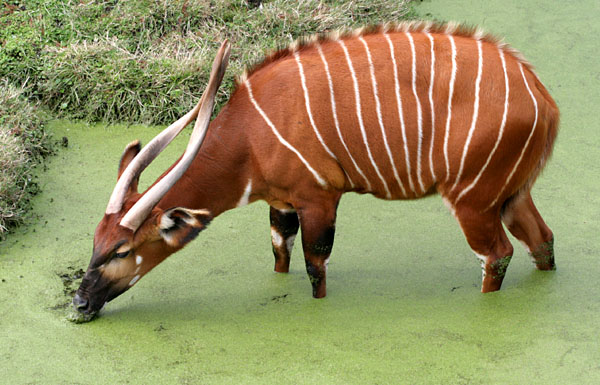|
Taurotragus
''Taurotragus'' is a genus of large antelopes of the African savanna, commonly known as elands. It contains two species: the common eland ''T. oryx'' and the giant eland ''T. derbianus''. Taxonomy ''Taurotragus'' is a genus of large African antelopes, placed under the subfamily Bovinae and family Bovidae. The genus authority is the German zoologist Johann Andreas Wagner, who first mentioned it in the journal ''Die Säugthiere in Abbildungen nach der Natur, mit Beschreibungen'' in 1855. The name is composed of two Greek words: ταῦρος (''taûros''), meaning a "bull" or "bullock", and τράγος (''trágos''), meaning a "male goat"—in reference to the tuft of hair that grows in the eland's ear which resembles a goat's beard. The genus consists of two species: ''Taurotragus'' is sometimes considered part of the genus ''Tragelaphus'' on the basis of molecular phylogenetics. Together with the bongo, giant eland and common eland are the only antelopes in the tribe '' ... [...More Info...] [...Related Items...] OR: [Wikipedia] [Google] [Baidu] |
Common Eland
The common eland (''Taurotragus oryx''), also known as the southern eland or eland antelope, is a savannah and plains antelope found in East and Southern Africa. It is a species of the family Bovidae and genus ''Taurotragus''. An adult male is around tall at the shoulder (females are shorter) and can weigh up to with a typical range of , for females). It is the second-largest antelope in the world, being slightly smaller on average than the giant eland. It was scientifically described by Peter Simon Pallas in 1766. Mainly a herbivore, its diet is primarily grasses and leaves. Common elands form herds of up to 500 animals, but are not territorial. The common eland prefers habitats with a wide variety of flowering plants such as savannah, woodlands, and open and montane grasslands; it avoids dense forests. It uses loud barks, visual and postural movements, and the flehmen response to communicate and warn others of danger. The common eland is used by humans for leather, meat, ... [...More Info...] [...Related Items...] OR: [Wikipedia] [Google] [Baidu] |
Common Eland
The common eland (''Taurotragus oryx''), also known as the southern eland or eland antelope, is a savannah and plains antelope found in East and Southern Africa. It is a species of the family Bovidae and genus ''Taurotragus''. An adult male is around tall at the shoulder (females are shorter) and can weigh up to with a typical range of , for females). It is the second-largest antelope in the world, being slightly smaller on average than the giant eland. It was scientifically described by Peter Simon Pallas in 1766. Mainly a herbivore, its diet is primarily grasses and leaves. Common elands form herds of up to 500 animals, but are not territorial. The common eland prefers habitats with a wide variety of flowering plants such as savannah, woodlands, and open and montane grasslands; it avoids dense forests. It uses loud barks, visual and postural movements, and the flehmen response to communicate and warn others of danger. The common eland is used by humans for leather, meat, ... [...More Info...] [...Related Items...] OR: [Wikipedia] [Google] [Baidu] |
Giant Eland
The giant eland (''Taurotragus derbianus''), also known as the Lord Derby eland and greater eland, is an open-forest and savanna antelope. A species of the family Bovidae and genus ''Taurotragus'', it was described in 1847 by John Edward Gray. The giant eland is the largest species of antelope, with a body length ranging from . There are two subspecies: ''T. d. derbianus'' and ''T. d. gigas''. The giant eland is a herbivore, eating grasses, foliage and branches. They usually form small herds consisting of 15–25 members, both males and females. Giant elands are not territorial, and have large home ranges. They are naturally alert and wary, which makes them difficult to approach and observe. They can run at up to and use this speed as a defence against predators. Mating occurs throughout the year but peaks in the wet season. They mostly inhabit broad-leafed savannas, woodlands and glades. The giant eland is native to Cameroon, Central African Republic, Chad, ... [...More Info...] [...Related Items...] OR: [Wikipedia] [Google] [Baidu] |
Giant Eland
The giant eland (''Taurotragus derbianus''), also known as the Lord Derby eland and greater eland, is an open-forest and savanna antelope. A species of the family Bovidae and genus ''Taurotragus'', it was described in 1847 by John Edward Gray. The giant eland is the largest species of antelope, with a body length ranging from . There are two subspecies: ''T. d. derbianus'' and ''T. d. gigas''. The giant eland is a herbivore, eating grasses, foliage and branches. They usually form small herds consisting of 15–25 members, both males and females. Giant elands are not territorial, and have large home ranges. They are naturally alert and wary, which makes them difficult to approach and observe. They can run at up to and use this speed as a defence against predators. Mating occurs throughout the year but peaks in the wet season. They mostly inhabit broad-leafed savannas, woodlands and glades. The giant eland is native to Cameroon, Central African Republic, Chad, ... [...More Info...] [...Related Items...] OR: [Wikipedia] [Google] [Baidu] |
Taurotragus Oryxx 1
''Taurotragus'' is a genus of large antelopes of the African savanna, commonly known as elands. It contains two species: the common eland ''T. oryx'' and the giant eland ''T. derbianus''. Taxonomy ''Taurotragus'' is a genus of large African antelopes, placed under the subfamily Bovinae and family Bovidae. The genus authority is the German zoologist Johann Andreas Wagner, who first mentioned it in the journal ''Die Säugthiere in Abbildungen nach der Natur, mit Beschreibungen'' in 1855. The name is composed of two Greek words: ταῦρος (''taûros''), meaning a "bull" or "bullock", and τράγος (''trágos''), meaning a "male goat"—in reference to the tuft of hair that grows in the eland's ear which resembles a goat's beard. The genus consists of two species: ''Taurotragus'' is sometimes considered part of the genus ''Tragelaphus'' on the basis of molecular phylogenetics. Together with the bongo, giant eland and common eland are the only antelopes in the tribe '' ... [...More Info...] [...Related Items...] OR: [Wikipedia] [Google] [Baidu] |
Taurotragus Oryx - Young Bull - Etosha 2015
''Taurotragus'' is a genus of large antelopes of the African savanna, commonly known as elands. It contains two species: the common eland ''T. oryx'' and the giant eland ''T. derbianus''. Taxonomy ''Taurotragus'' is a genus of large African antelopes, placed under the subfamily Bovinae and family Bovidae. The genus authority is the German zoologist Johann Andreas Wagner, who first mentioned it in the journal ''Die Säugthiere in Abbildungen nach der Natur, mit Beschreibungen'' in 1855. The name is composed of two Greek words: ταῦρος (''taûros''), meaning a "bull" or "bullock", and τράγος (''trágos''), meaning a "male goat"—in reference to the tuft of hair that grows in the eland's ear which resembles a goat's beard. The genus consists of two species: ''Taurotragus'' is sometimes considered part of the genus ''Tragelaphus'' on the basis of molecular phylogenetics. Together with the bongo, giant eland and common eland are the only antelopes in the tribe '' ... [...More Info...] [...Related Items...] OR: [Wikipedia] [Google] [Baidu] |
Taurotragus Derbianus Gigas
''Taurotragus'' is a genus of large antelopes of the African savanna, commonly known as elands. It contains two species: the common eland ''T. oryx'' and the giant eland ''T. derbianus''. Taxonomy ''Taurotragus'' is a genus of large African antelopes, placed under the subfamily Bovinae and family Bovidae. The genus authority is the German zoologist Johann Andreas Wagner, who first mentioned it in the journal ''Die Säugthiere in Abbildungen nach der Natur, mit Beschreibungen'' in 1855. The name is composed of two Greek words: ταῦρος (''taûros''), meaning a "bull" or "bullock", and τράγος (''trágos''), meaning a "male goat"—in reference to the tuft of hair that grows in the eland's ear which resembles a goat's beard. The genus consists of two species: ''Taurotragus'' is sometimes considered part of the genus ''Tragelaphus'' on the basis of molecular phylogenetics. Together with the bongo, giant eland and common eland are the only antelopes in the tribe '' ... [...More Info...] [...Related Items...] OR: [Wikipedia] [Google] [Baidu] |
Tragelaphus
''Tragelaphus'' is a genus of medium- to large-sized, spiral-horned antelopes. It contains several species of bovines, all of which are relatively antelope-like. Species in this genus tend to be large in size and lightly built, and have long necks and considerable sexual dimorphism. Elands, including the common eland (''Taurotragus oryx''), are embedded within this genus, meaning that ''Taurotragus'' must be subsumed into ''Tragelaphus'' to avoid paraphyly. Alternatively, ''Taurotragus'' could be maintained as a separate genus, if the nyala and the lesser kudu are relocated to their own monospecific genera, respectively ''Nyala'' and ''Ammelaphus''. Other generic synonyms include ''Strepsiceros'' (which applies to ''T. strepsiceros'') and ''Boocercus'' (for ''T. eurycerus''). The name "Tragelaphus" comes from the mythical tragelaph. Taxonomy and phylogeny ''Tragelaphus'' is a genus in the tribe Tragelaphini and the family Bovidae. The genus authority is French zoologist Henr ... [...More Info...] [...Related Items...] OR: [Wikipedia] [Google] [Baidu] |
Taurotragus Arkelli
''Taurotragus arkelli'' is an extinct species of eland from eastern Africa that lived during the Pleistocene. ''T. arkelli'' was roughly 5.5 meters long and 2.3 meters tall, making it larger than the extant Giant eland. Description ''Taurotragus arkelli'' was first described L.S.B. Leakey in 1965 from the Olduvai Gorge (Bed IV) in Tanzania. The material assigned to the species consists of a cranium and horn cores. ''T. arkelli'' is regarded as the ancestor of the modern common eland The common eland (''Taurotragus oryx''), also known as the southern eland or eland antelope, is a savannah and plains antelope found in East and Southern Africa. It is a species of the family Bovidae and genus ''Taurotragus''. An adult male is .... In comparison to modern eland, ''T. arkelli'' shows what are considered primitive characteristics for the genus, such as a longer braincase and horn cores slightly more upright. References {{Taxonbar, from=Q108391855 Prehistoric even-toed ungulate ... [...More Info...] [...Related Items...] OR: [Wikipedia] [Google] [Baidu] |
Bovinae
Bovines (subfamily Bovinae) comprise a diverse group of 10 genera of medium to large-sized ungulates, including cattle, bison, African buffalo, water buffalos, and the four-horned and spiral-horned antelopes. The evolutionary relationship between the members of the group is still debated, and their classification into loose tribes rather than formal subgroups reflects this uncertainty. General characteristics include cloven hooves and usually at least one of the sexes of a species having true horns. The largest extant bovine is the gaur. In many countries, bovid milk and meat Meat is animal flesh that is eaten as food. Humans have hunted, farmed, and scavenged animals for meat since prehistoric times. The establishment of settlements in the Neolithic Revolution allowed the domestication of animals such as chic ... is used as food by humans. Cattle are kept as livestock almost everywhere except in parts of India and Nepal, where they are Cattle in religion and mytholog ... [...More Info...] [...Related Items...] OR: [Wikipedia] [Google] [Baidu] |
Sitatunga
The sitatunga or marshbuck (''Tragelaphus spekii'') is a swamp-dwelling antelope found throughout central Africa, centering on the Democratic Republic of the Congo, the Republic of the Congo, Cameroon, parts of Southern Sudan, Equatorial Guinea, Burundi, Ghana, Botswana, Rwanda, Zambia, Gabon, the Central African Republic, Tanzania, Uganda and Kenya. The sitatunga is confined to swampy and marshy habitats. Here they occur in tall and dense vegetation as well as seasonal swamps, marshy clearings in forests, riparian thickets and mangrove swamps. Taxonomy and genetics The scientific name of the sitatunga is ''Tragelaphus spekii''. The species was first described by the English explorer John Hanning Speke in 1863. Speke first observed the sitatunga at a lake named "Little Windermere" (now Lake Lwelo, located in Kagera, Tanzania). In his book ''Journal of the Discovery of the Source of the Nile'', Speke called the animal "nzoé" (Kiswahili name for the animal) or "water-boc" (du ... [...More Info...] [...Related Items...] OR: [Wikipedia] [Google] [Baidu] |
Antelope
The term antelope is used to refer to many species of even-toed ruminant that are indigenous to various regions in Africa and Eurasia. Antelope comprise a wastebasket taxon defined as any of numerous Old World grazing and browsing hoofed mammals belonging to the family Bovidae of the order Artiodactyla. A stricter definition, also known as the "true antelopes," includes only the genera ''Gazella'', ''Nanger'', ''Eudorcas'' and ''Antilope''. One North American species, the pronghorn, is colloquially referred to as the "American antelope," but it belongs to a different family from the African and Eurasian antelopes. A group of antelope is called a herd. Unlike deer antlers, which are shed and grown annually, antelope horns grow continuously. Etymology The English word "antelope" first appeared in 1417 and is derived from the Old French ''antelop'', itself derived from Medieval Latin ''ant(h)alopus'', which in turn comes from the Byzantine Greek word ἀνθόλοψ, ''anthó ... [...More Info...] [...Related Items...] OR: [Wikipedia] [Google] [Baidu] |




_3.jpg)






